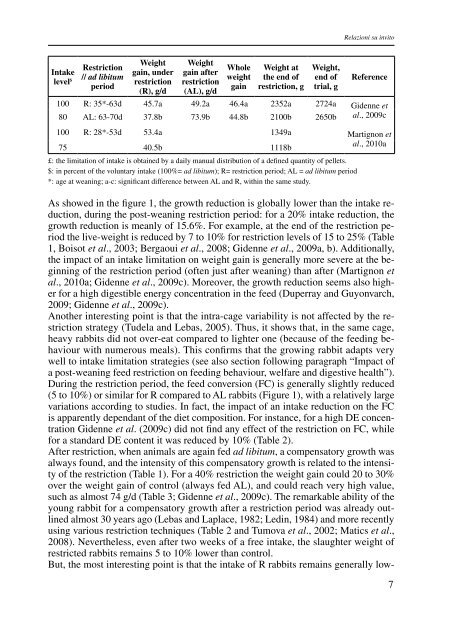atti delle giornate di coniglicoltura asic 2011 - Fondazione iniziative ...
atti delle giornate di coniglicoltura asic 2011 - Fondazione iniziative ...
atti delle giornate di coniglicoltura asic 2011 - Fondazione iniziative ...
You also want an ePaper? Increase the reach of your titles
YUMPU automatically turns print PDFs into web optimized ePapers that Google loves.
Intake<br />
level $<br />
Restriction<br />
// ad libitum<br />
period<br />
weight<br />
gain, under<br />
restriction<br />
(R), g/d<br />
weight<br />
gain after<br />
restriction<br />
(AL), g/d<br />
whole<br />
weight<br />
gain<br />
weight at<br />
the end of<br />
restriction, g<br />
weight,<br />
end of<br />
trial, g<br />
Relazioni su invito<br />
Reference<br />
100 r: 35*-63d 45.7a 49.2a 46.4a 2352a 2724a Gidenne et<br />
al., 2009c<br />
80 aL: 63-70d 37.8b 73.9b 44.8b 2100b 2650b<br />
100 r: 28*-53d 53.4a 1349a martignon et<br />
al., 2010a<br />
75 40.5b 1118b<br />
£: the limitation of intake is obtained by a daily manual <strong>di</strong>stribution of a defined quantity of pellets.<br />
$: in percent of the voluntary intake (100%= ad libitum); r= restriction period; aL = ad libitum period<br />
*: age at weaning; a-c: significant <strong>di</strong>fference between aL and r, within the same study.<br />
as showed in the figure 1, the growth reduction is globally lower than the intake reduction,<br />
during the post-weaning restriction period: for a 20% intake reduction, the<br />
growth reduction is meanly of 15.6%. For example, at the end of the restriction period<br />
the live-weight is reduced by 7 to 10% for restriction levels of 15 to 25% (Table<br />
1, boisot et al., 2003; bergaoui et al., 2008; Gidenne et al., 2009a, b). ad<strong>di</strong>tionally,<br />
the impact of an intake limitation on weight gain is generally more severe at the beginning<br />
of the restriction period (often just after weaning) than after (martignon et<br />
al., 2010a; Gidenne et al., 2009c). moreover, the growth reduction seems also higher<br />
for a high <strong>di</strong>gestible energy concentration in the feed (duperray and Guyonvarch,<br />
2009; Gidenne et al., 2009c).<br />
another interesting point is that the intra-cage variability is not affected by the restriction<br />
strategy (Tudela and Lebas, 2005). Thus, it shows that, in the same cage,<br />
heavy rabbits <strong>di</strong>d not over-eat compared to lighter one (because of the fee<strong>di</strong>ng behaviour<br />
with numerous meals). This confirms that the growing rabbit adapts very<br />
well to intake limitation strategies (see also section following paragraph “impact of<br />
a post-weaning feed restriction on fee<strong>di</strong>ng behaviour, welfare and <strong>di</strong>gestive health”).<br />
during the restriction period, the feed conversion (FC) is generally slightly reduced<br />
(5 to 10%) or similar for r compared to aL rabbits (Figure 1), with a relatively large<br />
variations accor<strong>di</strong>ng to stu<strong>di</strong>es. in fact, the impact of an intake reduction on the FC<br />
is apparently dependant of the <strong>di</strong>et composition. For instance, for a high de concentration<br />
Gidenne et al. (2009c) <strong>di</strong>d not find any effect of the restriction on FC, while<br />
for a standard de content it was reduced by 10% (Table 2).<br />
after restriction, when animals are again fed ad libitum, a compensatory growth was<br />
always found, and the intensity of this compensatory growth is related to the intensity<br />
of the restriction (Table 1). For a 40% restriction the weight gain could 20 to 30%<br />
over the weight gain of control (always fed aL), and could reach very high value,<br />
such as almost 74 g/d (Table 3; Gidenne et al., 2009c). The remarkable ability of the<br />
young rabbit for a compensatory growth after a restriction period was already outlined<br />
almost 30 years ago (Lebas and Laplace, 1982; Le<strong>di</strong>n, 1984) and more recently<br />
using various restriction techniques (Table 2 and Tumova et al., 2002; matics et al.,<br />
2008). nevertheless, even after two weeks of a free intake, the slaughter weight of<br />
restricted rabbits remains 5 to 10% lower than control.<br />
but, the most interesting point is that the intake of r rabbits remains generally low-<br />
7









